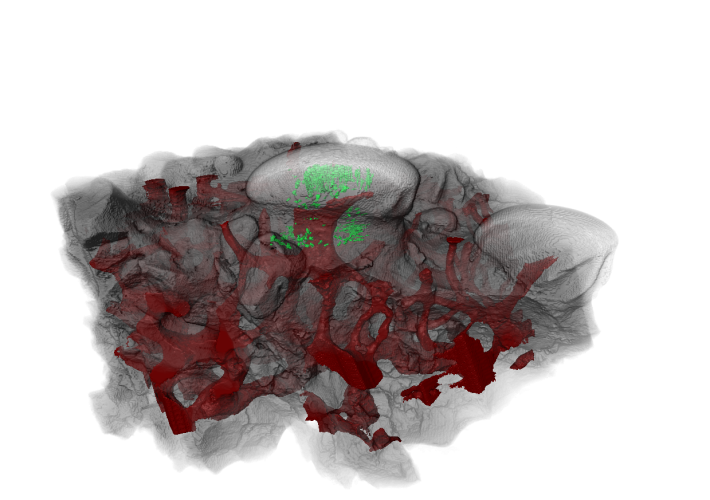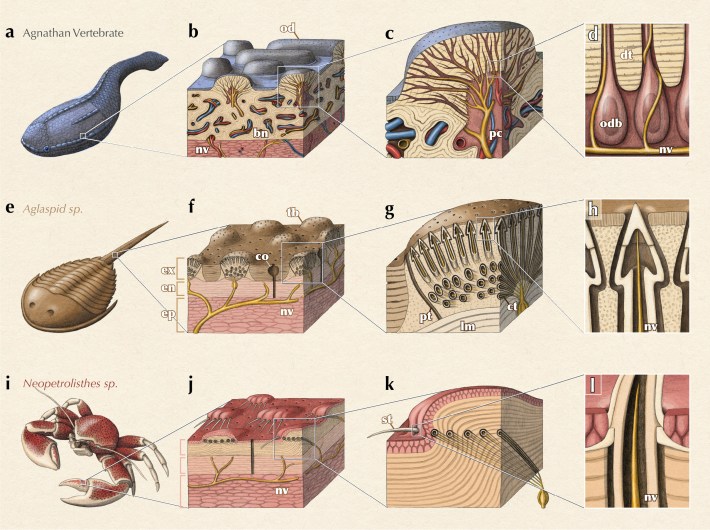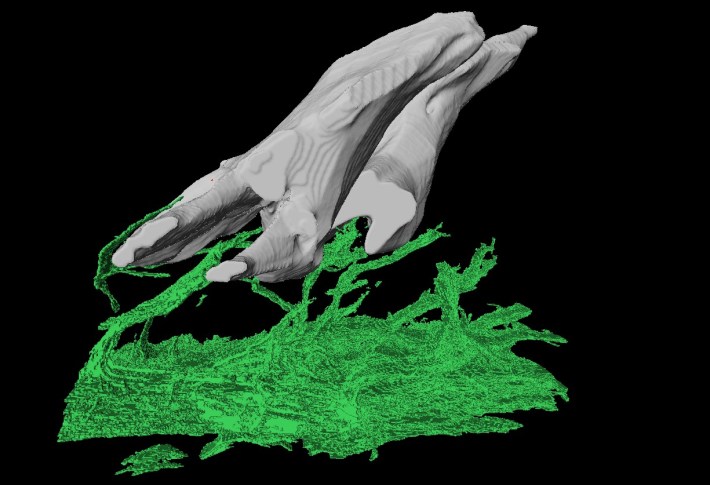Whenever Yara Haridy, a paleontologist at the University of Chicago, shows off the fossils she works with, people are often disappointed. Unlike the statuesque bones of dinosaurs or even the small spirals of ancient seashells, Haridy’s fossils “kind of look like dust, or like the last little bit in your cereal,” she said, adding that scientists call them “fish flakes.” These fossils are too tiny to spot, let alone excavate on site. Instead, geologists take layers of rock and dissolve them in acid, revealing the bones and other organic bits left behind. This is how researchers first discovered the fish flakes, after the mote-like fossils suddenly appeared at a certain point in Cambrian rocks.
Earth’s earliest vertebrates are little more than squishy, wormy critters with no hard parts of their own. But after about a 20-million-year gap, suddenly the record shows vertebrates “that look like small little armored tanks or Roombas that are swimming around,” said Karma Nanglu, a paleobiologist at Harvard University’s Museum of Comparative Zoology. Haridy hoped that the fish flakes might help fill in the gap: a hypothetical vertebrate somewhere between “the squishy guys and the fully formed fish.”
Haridy joined the lab of Neil Shubin, one of the paleontologists who discovered the transitional fossil Tiktaalik, to figure out how creatures made this jump. If Shubin studies water-to-land transitions, Haridy studies squish-to-skeleton transitions. Plenty of animals that have thrived for millions of years, such as jellyfish and amoebas, as little more than goop. In Haridy’s words: “Why have a skeleton? Why not just be a goop monster?”
While Haridy initially came to Chicago to find the earliest vertebrate fish, her project mutated after she unmasked a creature called Anatolepis, long considered the earliest vertebrate on record, as an invertebrate. In a paper recently published in Nature, Haridy sets the record straight regarding Anatolepis, and also revealed that teeth—yours, mine, every vertebrate’s— first evolved as sensory structures from the exoskeletons of ancient armored fish.
“The conclusions drawn in the paper are incredibly exciting, and this opens the field to test these ideas of an initial function for the teeth, whether in the mouth or in the skin,” Gareth J. Fraser, an evolutionary developmental biologist at the University of Florida who was not involved with the research, wrote in an email.
As Haridy sifted through scientific papers describing possible early vertebrates from the Cambrian period, she often contacted Nanglu, who specializes in invertebrates and is also an author on the paper. Haridy messaged Nanglu questions about the creatures she came across, such as: “Please, God, tell me something about this. Is this a legit fossil? What’s going on?” Nanglu recalled. The researchers winnowed down many squishy, wormy, eyeless creatures of the Cambrian to a manageable few that produced hardened body parts.
They homed in on Anatolepis, which lived around 500 million years ago, far older than any other established vertebrate. The fossil had one of the traits of early vertebrates: little bumps called odontodes, which are made of a hardened tissue called dentin, a major component of teeth. An odontode looks distinctively toothy, particularly under a microscope. It has a central cavity and a pulp cavity with little sprouting tubules, just like a tooth. Initial scans of an Anatolepis bump revealed a cavity with tubules—”the telltale signs of a tooth,” Haridy said.
To get clearer scans of such tiny fossils, Haridy booked a 24-hour appointment at the Argonne National Laboratory in Lemont, Ill., to use one of the U.S.’s few particle accelerators. These machines use extremely strong magnets to bend electrons and create powerful X-rays. “It’s about 100 billion times more powerful than the X-rays at your local hospital,” Haridy said. Argonne is funded federally by the U.S. Department of Energy and was free to use for Haridy’s research. Her team raced through the night scanning hundreds of fish flakes and other tiny samples from modern vertebrates and invertebrates. Each flake sat on the end of a plastic cocktail toothpick and was rotated in front of the beam as the machine took thousands of images to produce a 3D model.

Anatolepis‘s bumps were dazzlingly intricate; the tubules sprouting from each cavity had tiny mineralized hats and sheaths leading to extra holes. “This work really highlighted the beauty of this system of cellular relics,” Fraser said.
When Haridy looked through the data, she noticed the Anatolepis bumps looked uncannily similar to bumps on other fossil arthropods, confirming it was not a vertebrate. “My heart just sank,” she said.
Still, Haridy understood why people had mistaken Anatolepis for a vertebrate. Invertebrates are understudied, and vertebrates are overly spotlighted, not to mention the fact that people often associate complexity with vertebrates. “We tend to think vertebrates are special, [that] we’re high up in the tree. And there’s that false equivalency of, because we’re special, we’re the most complicated,” Haridy said. “But, man, we are wrong about that.” And to Nanglu, the similarity of the structures used by both ancient arthropods and modern vertebrates reveals “that kind of beautiful symmetry of evolution.”
Haridy was left with a new research question: “Why the heck does it still look so much like a tooth?” Javier Ortega-Hernández, an invertebrate paleontologist at Harvard University and an author on the paper, identified Anatolepis as an extinct marine arthropod called an agalaspid, an ancestor of scorpions, spiders, and crabs. When the researchers scanned some modern specimens, they found modern crabs and horseshoe crabs have similar bumps on their exoskeletons that act as sensory organs, helping the arthropods sense things like pressure, chemistry, and air flow.

When Haridy showed the sensory bumps to Shubin, he reminded her that teeth are sensory structures, too, something anyone who has experienced a root canal knows well. The established theory suggests that our teeth evolved from the bumpy exoskeletons of ancient, armored fish. What is less certain, however, is whether the teeth evolved sensation later, or if they had sensory capabilities before moving into the mouth.
While Haridy had no way of telling if the bumps of fossilized fish were sensitive, she could ask this question of a modern fish covered in external teeth. Haridy opted for catfish, which she bought from a pet store. The fish bred like bunnies in her aquarium, allowing her to image the embryos. The researchers discovered that the catfish’s nerves traveled into each one of its external teeth, the same way our nerves travel into our own teeth.

There are two competing theories around how the odontodes of ancient fish became modern teeth, Fraser explains. The “outside-in” theory suggests that sensitive bumps on ancient fish exoskeletons eventually migrated to the mouth, becoming teeth. The “inside-out” theory suggests that teeth evolved multiple times, first inside the pharynx of jawless fish and later as tooth-like structures on fish skin. “Most paleontologists now consider the outside-in theory as the consensus and answer to the question of tooth origins; however, the inside-out theory has its supporters,” said Fraser, who has proposed one version of an inside-out theory.
This study’s findings support the “outside-in” theory. Fraser said he found this new data reasonable and convincing, and added that this new paper allows “inside-out” supporters to focus their studies on an alternative. “The fossil record is far from complete, thus there are endless discoveries that could hold pieces of the puzzle,” he said.
So while Haridy did not find the earliest vertebrate, she did help explain the story of our teeth across deep time—how some of our biological quirks, such as why it hurts to bite into a popsicle, are simply a part of our evolutionary story. Meanwhile, her larger quest still continues. “The big gap between squishy boys and fully-formed fish still remains,” she said.